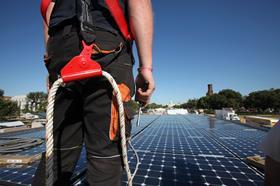Installing solar PV panels is an attractive option for developers, but there are a number of issues to look out for

Feed-in tariffs (FITs) and solar panels
Solar PV systems can help developers meet planning conditions and achieve a higher Code for Sustainable Homes rating. They are also income generating (via FITs). However, a number of issues should be considered before embracing solar.
Changing tariff levels
Those considering solar as a way of generating income should understand how the tariffs are set and ensure that the available FITs are sufficient to justify investment.
The tariff applicable at the time of installation is payable for the whole of the fixed period (now 20 years for solar). However, the tariffs are index-linked and can go up or down annually in line with RPI.
The tariffs for new installations were reduced on 1 August 2012 and from 1 October 2012 the tariffs will be reduced on a quarterly basis according to deployment levels. In addition lower tariffs apply to multi-installations (those with more than 25 installations only receive 90% of the full FITs).
How are the solar panels paid for?
Property owners can finance the installation themselves (and benefit directly from the FITs). Note, however, that generally FITs cannot be claimed where public funds have been used to purchase/install the panels.
Alternatively, property owners can enter into a ‘Rent a roof’ scheme. Under such schemes:
- the property owner (landlord) grants the installation company (tenant) a lease over their roof space (normally for 20 years)
- the tenant owns the panels, pays for their installation, connection and maintenance and receives the FITs income
- the landlord can receive rent from the tenant and/or use the electricity generated.
Are there particular lease terms to look out for?
Yes:
- break rights; are there any and what are the costs of exercising them? What if
- the landlord wants to redevelop?
- accreditation is refused/lost (FITs payments can only be made in relation to accredited installations)?
- compensation clauses; many FITs leases require the landlord to pay compensation to the tenant in a number of situations, including if the lease is terminated early, or repairs to the property mean the panels have to be switched off.
- security of tenure; the FITs lease should be contracted out of Part 2 of the Landlord and Tenant Act 1954 (otherwise the tenant could renew the lease at the end of lease term).
- as it is the ‘owner’ of the solar PV system who benefits from the FITs, the panels must not become a landlord’s fixture. The lease should declare that the panels belong to the tenant (and should be removed at the end of the term).
What consents are needed?
The installation must comply with planning, building regulations and statutory requirements (oblige the installer to obtain all necessary consents). The impact of the panels on the fire risk assessment and buildings insurance should also be considered.
Third party consents required by the title deeds will be needed (including superior landlord’s consent if the property owner is themselves a tenant).
For mortgaged property, bank’s consent will be required (see the CML and BSA guidance on lender’s requirements). Note that the attitude of lenders varies considerably and existence of a ‘rent a roof’ scheme can make refinancing difficult.
Right to buy sales: Council landlords should consider the impact of ‘rent a roof’ schemes on right to buy sales. In particular, are there restrictions in the lease on the disposal of the property? Will the presence of solar PVs deter right to buy purchasers (or make it harder for them to obtain finance)?
Practical issues: Where will the panels be fitted (will a crane/scaffolding be needed?). Will they have a detrimental effect on the property’s appearance (thus affecting value)? Consider cable routes, riser capacity and meter/inverter locations. Bear in mind that the presence of solar panels will almost certainly curtail the owner’s ability to develop the roof space or develop upwards. What about repairs to the roof? The existence of the solar panels could make such repairs more difficult/costly.
Sunlight: Although obvious, don’t overlook the fact that solar panels require sunlight to function (presently, it is uncertain whether existing rights of light law will assist owners faced with reduced lighting to their solar panels caused by neighbouring development). Installation is not advisable if the owner is aware of extensive (and high-rise) redevelopment proposals next door!
Martin Codd is a partner at Penningtons Solicitors



























No comments yet